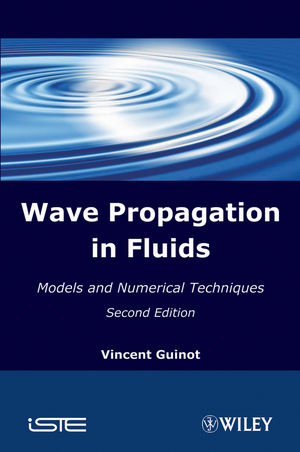
Wave Propagation in Fluids
ISTE Ltd and John Wiley & Sons Inc (Verlag)
978-1-84821-213-8 (ISBN)
- Titel z.Zt. nicht lieferbar
- Versandkostenfrei innerhalb Deutschlands
- Auch auf Rechnung
- Verfügbarkeit in der Filiale vor Ort prüfen
- Artikel merken
This second edition with four additional chapters presents the physical principles and solution techniques for transient propagation in fluid mechanics and hydraulics. The application domains vary including contaminant transport with or without sorption, the motion of immiscible hydrocarbons in aquifers, pipe transients, open channel and shallow water flow, and compressible gas dynamics.
The mathematical formulation is covered from the angle of conservation laws, with an emphasis on multidimensional problems and discontinuous flows, such as steep fronts and shock waves.
Finite difference-, finite volume- and finite element-based numerical methods (including discontinuous Galerkin techniques) are covered and applied to various physical fields. Additional chapters include the treatment of geometric source terms, as well as direct and adjoint sensitivity modeling for hyperbolic conservation laws. A concluding chapter is devoted to practical recommendations to the modeler.
Application exercises with on-line solutions are proposed at the end of the chapters.
Vincent Guinot is professor of hydrodynamic modeling at the University of Montpellier, France. He teaches fluid mechanics, hydraulics, numerical methods and hydrodynamic modeling.
Introduction xv
Chapter 1. Scalar Hyperbolic Conservation Laws in One Dimension of Space 1
1.1. Definitions 1
1.2. Determination of the solution 9
1.3. A linear law: the advection equation 14
1.4. A convex law: the inviscid Burgers equation 21
1.5. Another convex law: the kinematic wave for free-surface hydraulics 28
1.6. A non-convex conservation law: the Buckley-Leverett equation 35
1.7. Advection with adsorption/desorption 42
1.8. Summary of Chapter 1 47
Chapter 2. Hyperbolic Systems of Conservation Laws in One Dimension of Space 53
2.1. Definitions 53
2.2. Determination of the solution 59
2.3. A particular case: compressible flows 63
2.4. A linear 2×2 system: the water hammer equations 68
2.5. A nonlinear 2×2 system: the Saint Venant equations 84
2.6. A nonlinear 3×3 system: the Euler equations 108
2.7. Summary of Chapter 2 122
Chapter 3. Weak Solutions and their Properties 131
3.1. Appearance of discontinuous solutions 131
3.2. Classification of waves 138
3.3. Simple waves 142
3.4. Weak solutions and their properties 144
3.5. Summary 157
Chapter 4. The Riemann Problem 161
4.1. Definitions – solution properties 161
4.2. Solution for scalar conservation laws 165
4.3. Solution for hyperbolic systems of conservation laws 173
4.4. Summary 189
Chapter 5. Multidimensional Hyperbolic Systems 193
5.1. Definitions 193
5.2. Derivation from conservation principles 197
5.3. Solution properties 200
5.4. Application: the two-dimensional shallow water equations 208
5.5. Summary 221
Chapter 6. Finite Difference Methods for Hyperbolic Systems 223
6.1. Discretization of time and space 223
6.2. The method of characteristics (MOC) 227
6.3. Upwind schemes for scalar laws 244
6.4. The Preissmann scheme 250
6.5. Centered schemes 260
6.6. TVD schemes 263
6.7. The flux splitting technique 271
6.8. Conservative discretizations: Roe’s matrix 280
6.9. Multidimensional problems 284
6.10. Summary 289
Chapter 7. Finite Volume Methods for Hyperbolic Systems 293
7.1. Principle 293
7.2. Godunov’s scheme 299
7.3. Higher-order Godunov-type schemes 313
7.4. EVR approach 319
7.5. Summary 326
Chapter 8. Finite Element Methods for Hyperbolic Systems 329
8.1. Principle for one-dimensional scalar laws 329
8.2. One-dimensional hyperbolic systems 340
8.3. Extension to multidimensional problems 344
8.4. Discontinuous Galerkin techniques 347
8.5. Application examples 354
8.6. Summary 368
Chapter 9. Treatment of Source Terms 371
9.1. Introduction 371
9.2. Problem position 372
9.3. Source term upwinding techniques 377
9.4. The quasi-steady wave algorithm 386
9.5. Balancing techniques 390
9.6. Computational example 403
9.7. Summary 408
Chapter 10. Sensitivity Equations for Hyperbolic Systems 411
10.1. Introduction 411
10.2. Forward sensitivity equations for scalar laws 413
10.3. Forward sensitivity equations for hyperbolic systems 422
10.4. Adjoint sensitivity equations 435
10.5. Finite volume solution of the forward sensitivity equations 441
10.6. Summary 447
Chapter 11. Modeling in Practice 449
11.1. Modeling software 449
11.2. Mesh quality 454
11.3. Boundary conditions 459
11.4. Numerical parameters 464
11.5. Simplifications in the governing equations 466
11.6. Numerical solution assessment 472
11.7. Getting started with a simulation package 477
Appendix A. Linear Algebra 479
Appendix B. Numerical Analysis 487
Appendix C. Approximate Riemann Solvers 505
Appendix D. Summary of the Formulae 521
Bibliography 527
Index 537
| Erscheint lt. Verlag | 14.9.2010 |
|---|---|
| Verlagsort | London |
| Sprache | englisch |
| Maße | 163 x 241 mm |
| Gewicht | 930 g |
| Themenwelt | Naturwissenschaften ► Physik / Astronomie ► Mechanik |
| Technik ► Maschinenbau | |
| ISBN-10 | 1-84821-213-5 / 1848212135 |
| ISBN-13 | 978-1-84821-213-8 / 9781848212138 |
| Zustand | Neuware |
| Haben Sie eine Frage zum Produkt? |
aus dem Bereich


